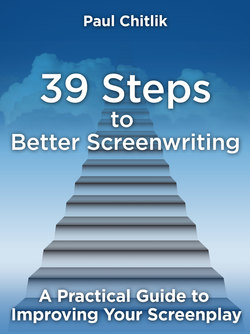Читать книгу 39 Steps to Better Screenwriting - Paul Chitlik - Страница 9
На сайте Литреса книга снята с продажи.
ОглавлениеStep 3
An End, A Beginning, And A Middle
Yes, the words in the chapter title are out of order, but when you tell a story, does it have to be in a certain order? Most of the time, the answer to that is yes, at least for a movie. The story, though not the filming, almost always goes in chronological order. That’s because it’s easier to understand a film that way and easier to cut together. But what if there’s another way to tell a story?
Of course there is. When you tell a story to a friend, whether it’s about you or someone else, you often start at the end and then go back and fill in the details. As you tell it, you remember something else that happened earlier and tell that and then go back to the main story. You might skip ahead when your listener asks a question. You might then double back to the beginning to summarize where you are to remind the listener.
Film writers, directors, and editors do this all the time. Mostly, it’s called flashbacks. Woody Allen’s film, Blue Jasmine, is full of them, though many films are filled with exposition to get you to understand what’s going on with the main character. You can probably name a dozen films with flashbacks in them, which are sometimes used, as in Allen’s film, as a way to give context to what’s happening now in the story. So the beginning doesn’t come at the beginning, the middle doesn’t come at the middle, but the end still will usually come at the end.
Unless, of course, you’re Quentin Tarantino, Roger Avary, Guillermo Arriaga, or Alejandro González Iñárritu. Or me. Tarantino and Avary took four stories and interwove them to make one movie that really surprised you — Pulp Fiction. Arriaga and Iñárritu wove three stories into 21 Grams, then used the same technique on Babel. These stories don’t necessarily jump back and forth in time like you would do when telling a friend a story, but they’re more like two or three people trying to tell their stories at the same time.
Is that a good thing? I didn’t used to think so. I thought Pulp Fiction was an ordinary movie made extraordinary by editing. I thought 21 Grams and Babel were less than ordinary movies made less than ordinary by editing. Then I ran into a problem with my own film, The Wedding Dress, which I shot in sequence and edited in chronological order. The story, in which a family wedding dress forces three generations of women to confront the challenges of who they love, is three different stories that feature mothers and daughters from generation to generation. In order, it dragged. But cut asynchronously, as suggested by Mark Evan Schwartz, a colleague at Loyola Marymount University, it sings. It’s more cinematic. And it makes sense as the themes and even some of the dialogue move from generation to generation.
So what I’m getting at here is that there is no one order in which to tell your story. You still must have a beginning, a middle, and an end, but they don’t necessarily have to come in that order. This is best experimented with at the script stage because, believe me, it’s hell to do later. But it can be done and sometimes should be done. Try it. It may work for you. You’ve got nothing to lose but time and paper.
